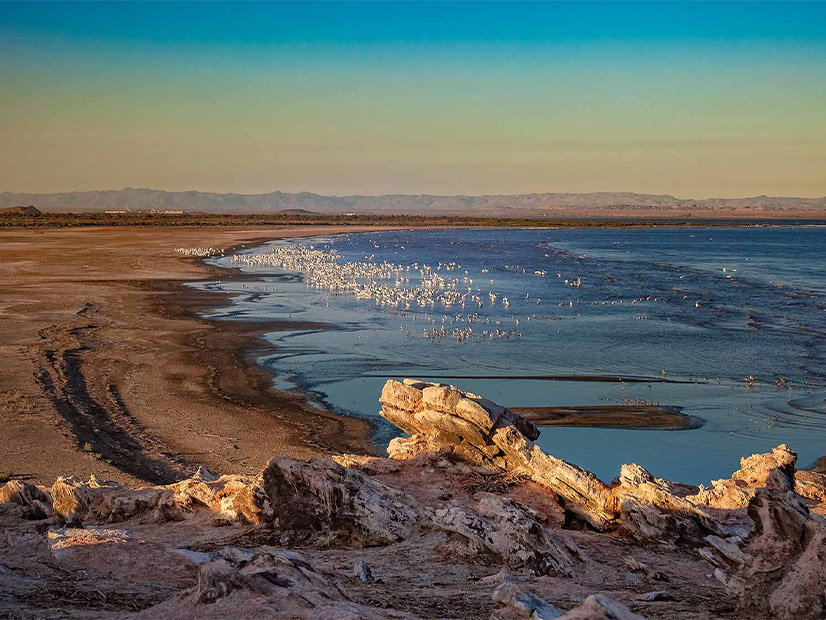
California PUC President Alice Reynolds set the tone for the theme of climate resilience at the group's annual meeting with a story about the history of the Salton Sea.
LA QUINTA, Calif. — California PUC President Alice Reynolds set the tone for the theme of climate resilience at the National Association of Regulatory Utility Commissioners Annual Meeting with a story about the history of the Salton Sea.
In her opening remarks at the conference Nov. 13, Reynolds explained how the sea — a highly saline body of water in the Southern California desert about an hour from the conference location — was created by an extreme weather event in 1905 when Colorado River floodwater breached an irrigation canal and spilled into the Salton Sink.
The landlocked body of water is now considered a key domestic mining location of a critical mineral needed to manufacture batteries for the energy transition: lithium.
“There’s so much history related to the Salton Sea before this event and after, but I wanted to raise it as an early lesson in resiliency and also an event that created opportunity,” Reynolds said. The Salton “provides the potential for sustainable extraction of lithium and for geothermal generation, both of which are needed for our clean energy transition.” (See ‘Lithium Valley’ Could Accelerate California EV Sector Growth.)
In the future, Reynolds said, inevitable climate-caused extreme weather events could present an opportunity to develop new technologies — like using lithium from the Salton Sea to power electric vehicles — to better adapt to climate change.
Funding for Climate Mitigation
On the heels of Reynolds’ speech, many discussions at the conference centered on the crucial role the energy sector will play in building the infrastructure needed for climate mitigation and resilience.
David Crane, undersecretary of infrastructure at the Department of Energy, discussed DOE’s role in addressing climate change.
“We want to transition the country to a clean energy economy while being true to the historic mission of the electricity industry, in particular to deliver safe, affordable and reliable power,” Crane said during a panel.
The panel’s moderator, Commissioner Ann Rendahl of the Washington Utilities and Transportation Commission, asked what DOE planned to do with the historic funding it received from the country’s Infrastructure Investment and Jobs Act and the Inflation Reduction Act. According to Crane, the agency was given $96 billion for financial assistance equity grants, and its Loan Program Office has around $400 billion in loan capacity.
DOE plans to use $10 billion for the Home Energy Rebate Program, which funds home energy efficiency and electrification projects. In August, DOE also announced up to $300 million for the Transmission Siting and Economic Development grant program, which helps fund transmission projects, grid modernization and wildfire mitigation.
The agency plans to announce an additional $20 billion in funding in the next few months, with the hopes of allocating it by the end of 2024, Crane said.
Tools for Resilience
Industry officials and regulators emphasized the need to look beyond mitigation toward creating a system of resilience that can support the country in the event of a climate disaster.
“Today, I think resilience is coming much more into the forefront,” said Katie Jereza, vice president of corporate affairs at the Electric Power Research Institute (EPRI). “Because we’re going to be more reliant on electricity, resilience is going to be of much more value in the future.”
Commissioner Tammy Cordova of the Nevada Public Utilities Commission echoed those concerns, saying that for utilities to deliver the level of reliability demanded, they need to be resilient in the face of climate change.
During a panel moderated by Cordova, Curt Stokes, senior attorney with the Environmental Defense Fund, highlighted the need to understand risk.
“What we advocate for is, as the electrical utility is planning and understanding how it serves its customers and as we work with individual communities and parts of the communities, understand what risks they’re facing and the role of the electrical utility grid in making sure that those communities are resilient,” Stokes said.
Morgan Scott, director of Climate READi at EPRI, discussed a tool designed to increase the power sector’s collective approach to managing climate risk.
Climate READi has three main components.
The first is understanding the type of data that exists to characterize climate hazards to a power station.
The second outlines how to use the data to assess risk to assets and inform design criteria for new assets that will be needed. As part of the effort, EPRI is building a climate asset matrix that lists every asset on the power system and each weather variable it could be exposed to.
The third component brings this information to a system level, looking at what assets need to be prioritized in the event of an extreme weather event.
Forty-two electric sector companies and over 80 stakeholder organizations in the U.S., Canada, the U.K. and France have joined Climate READi.
Andy Bochman, senior grid strategist with Idaho National Laboratory, spoke about the Climate Resilience Maturity Model, which considers the well-being of different infrastructure assets and ranks cities in terms of vulnerability and readiness. The model, which is promoted by the Environmental Defense Fund, can be used by energy regulators to hold utilities accountable to their obligation to provide safe, reliable and affordable service by managing climate related risks and building resilient systems.
Energy officials asserted that the tools they’ve developed are important steps in the right direction, but that more needs to be done.
“We spend a lot of time talking about mitigation, and we should, but with emissions rising every year, we’re not really getting much performance bang for all the noise and expenditure buck,” Bochman said. “We are building wind, solar and storage, EVs are coming — I have one, I have solar panels — but that’s not changing the amount of emissions that are going out globally appreciably, so we need much more attention on resilience and adaptation than it’s getting right now.”

